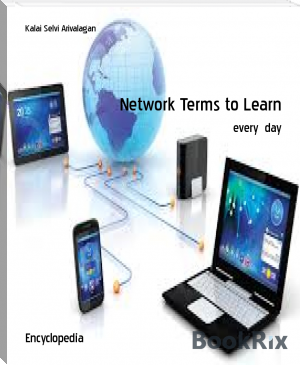Network Terms to Learn - Kalai Selvi Arivalagan (best love novels of all time .TXT) 📗

- Author: Kalai Selvi Arivalagan
Book online «Network Terms to Learn - Kalai Selvi Arivalagan (best love novels of all time .TXT) 📗». Author Kalai Selvi Arivalagan
Hopfield Network
A Hopfield network is a specific type of recurrent artificial neural network based on the research of John Hopfield in the 1980s on associative neural network models. Hopfield networks are associated with the concept of simulating human memory through pattern recognition and storage.
Learning Algorithm
A learning algorithm is an algorithm used in machine learning to help the technology to imitate the human learning process. Combined with technologies like neural networks, learning algorithms create involved, sophisticated learning programs.
Unified Endpoint Management
Unified endpoint management (UEM) refers to an architecture and approach that controls different types of devices such as computers, smartphones and IoT devices from a centralized command point. These types of systems help to make diverse networks safer and more efficient.
Adaptive Resonance Theory
Adaptive resonance theory (ART) is a particular philosophy driving unsupervised artificial neural network models. It uses a specific architecture, often useful in some types of neural networks, to try to build the capacity for new learning while keeping in place fundamental existing models.
Explainable Artificial Intelligence
Explainable artificial intelligence (XAI) is a key term in AI design and in the tech community as a whole. It refers to efforts to make sure that artificial intelligence programs are transparent in their purposes and how they work. Explainable AI is a common goal and objective for engineers and others trying to move forward with artificial intelligence progress.
Boot Sector
Boot sector is a reserved sector of a disk or storage device that contains the necessary data or code used to complete the boot process of a disk or a computer. Boot sector is also known as boot block.
Mean Swaps Between Failures
Mean Swaps Between Failures (MSBF) is a specific term used by automated equipment manufacturers that refers to the durability of manufactured systems or products. It is similar to other metrics, including Mean Time Between Failures (MTBF), Mean Time To Repair (MTTR) and Mean Time Between Breakdowns (MTBB). All refer to the projected length of time of a tested product before failure or breakdown.
Ferrule
A ferrule is a component in fiber optics used for protecting and aligning the stripped fiber end. The fiber is inserted into the thin structure of the ferrule and provided with an adhesive to prevent contamination as well as to give it long-term mechanical strength. It is a major and costly component in a fiber connector, other ones being coupling mechanisms and the connector bodies. A poor connection can be the result of errors in length, hole centering or inside and outside diameter matching.
Exokernel
Exokernel is an operating system developed at the Massachusetts Institute of Technology that seeks to provide application-level management of hardware resources. The exokernel architecture is designed to separate resource protection from management to facilitate application-specific customization. Exokernels are typically small in size because of their limited operability.
Catch Block
A catch block, in C#, is an optional block of code that is executed when an exception is raised. Catch block is a specific part of the exceptional handling construct, and is implemented using the "catch" keyword in combination with keywords "try" and "finally" and forms the means to implement structured exception handling. A try block includes the guarded code that can cause the exception. It encloses statements that deal with exceptional circumstances and works to recover from such unexpected conditions. Catch block forms the means for handling exceptions. If these are not handled, this can lead to termination of the entire program by the .NET run time. A catch block can be used for handling any or specific exceptions.
Hardcode
A hardcode is a part of a computer program which cannot be altered in any way except by changing the source code of the program itself. This means that if the software has already been compiled and made into an executable, the hardcoded portion of the program stays constant no matter what is done to the software. This is usually done for certain fixed parameters and values that should always be constant, like Pi or the speed of light. The process of creating a hardcode is known as hardcoding.
Wireless Network Engineer
A wireless network engineer is an individual proficient in handling all tasks related to the setup, maintenance and troubleshooting of a
wireless network. This applies to small residential wireless networks or larger and more complex commercial networks.
Dynamic Smart Cooling
Dynamic Smart Cooling is a technology used to monitor power and cooling in data centers. Dynamic Smart Cooling uses a feedback-based control system to provide hot spot control to facility managers. Dynamic Smart Cooling uses sensors that are placed throughout a facility, such as in computer racks, to provide feedback to a central server. System software indicates hot spot locations and increases/decreases cooling as needed.
Parallel Processing
Parallel processing is a method of simultaneously breaking up and running program tasks on multiple microprocessors, thereby reducing processing time. Parallel processing may be accomplished via a computer with two or more processors or via a computer network. Parallel processing is also called parallel computing.
Phishing
Phishing is the fraudulent act of acquiring private and sensitive information, such as credit card numbers, personal identification and account usernames and passwords. Using a complex set of social engineering techniques and computer programming expertise, phishing websites lure email recipients and Web users into believing that a spoofed website is legitimate and genuine. In actuality, the phishing victim later discovers his personal identity and other vital information have been stolen and exposed.
Graph Database
A graph database is a type of NoSQL database that stores data in collections of nodes and edges instead of a series of columns and rows. Each node represents a data point and each edge defines a relationship between two nodes. Graph databases use graph theory models to illustrate how data points are related. This type of database is useful for storing data that has complex, indirect relationships and querying the shortest path between two data points. A graph database may also be referred to as a knowledge graph or graph-oriented database. Popular graph database platforms include Neo4j, Tigergraph and Amazon Neptune.
Session Cookie
A session cookie is a file containing an identifier (a string of letters and numbers) that a website server sends to a browser for temporary use during a limited timeframe. Session cookies are enabled by default. Their purpose is help individual web pages load faster and improve navigation through a website. Each time the browser requests a web page from the server, it includes the session cookie file with its request. The cookie lets the server know which page components the browser has already been sent, so the server doesn't waste time re-sending them. When the browser closes at the end of a session, the file is deleted.
A session cookie is also known as transient cookie. This type of cookie is stored in temporary memory and is only available during an active browser session. End users can adjust browser settings to decline session cookies, however this often results in a poor user experience.
Term of the day - 19 Inference
Inference is a database system technique used to attack databases where malicious users infer sensitive information from complex databases at a high level. In basic terms, inference is a data mining technique used to find information hidden from normal users.
An inference attack may endanger the integrity of an entire database. The more complex the database is, the greater the security implemented in association with it should be. If inference problems are not solved efficiently, sensitive information may be leaked to outsiders.
Data Cholesterol
Data cholesterol is a slang term that refers to the slowing effect that huge amounts of improperly managed information can have on an organization's IT infrastructure. Large amounts of data can slow applications, make it difficult to find relevant information and generally impede an organization. Data cholesterol has many causes, including increased regulatory requirements that require more information to be stored for longer amounts of time, and a general increase in data gathering and analytical techniques.
Peppermint
Peppermint is an open-source, light-weight, fully-featured operating system based on Ubuntu Linux that is geared towards for cloud computing. It is fast in loading and in shutting down, includes an intuitive interface, and is optimized for Web-based applications. Peppermint is named after the OS Linux Mint.
Block Bit Transfer
A bit block transfer is a procedure to transfer blocks of memory, often in the form of visual pixels, between destinations. The term goes back to the 1970s and the use of this sort of routine for sending bitmap graphics in blocks. For example, A bit block transfer process may be used to render sprites onto a visual background. A bit block transfer is also known as bit blit, BLT or BITBLT.
Finally Block
A finally block, in the context of C#, refers to a block of statements that are always executed, regardless of unexpected events or exceptions that may occur during an application's execution. It is used optionally with the "try/catch" block and guarantees the execution of any code that must be executed before exiting the "try" block, regardless of the success or failure of the application's execution. The execution of a finally block is intended to release resources, such as database connections, which are usually available in limited quantities. By this mechanism, the disposal of resources occurs earlier than the garbage collector's finalization operation, thereby optimizing memory.
Capsule Network
A capsule network is a kind of shorthand term for a specific kind of neural network pioneered by Stanford scientist Geoffrey Hinton. In the capsule network, specific methodology is applied to image processing to try to affect an understanding of objects from a three-dimensional spectrum.
Network as a Service
Network as a service (NaaS) is a term that has arisen in the pantheon of software as a service (SaaS) options that are now popular in today's enterprise IT world. Network as a service consists of offering network functionality on a subscription basis, often through the cloud. Network as a service providers virtualize the network setup and give customers the ability to utilize a network that is not really set up in on-premises hardware.
Blockchain Economy
Blockchain economy is a term for a move toward cryptocurrencies and digital ledger systems, and away from traditional national hard currencies and legacy ledger systems. In the blockchain economy, technologies like bitcoin and blockchain are the typical tools for financial management, rather than traditional software programs managing national currencies.
Omnidirectional Treadmill
An omnidirectional treadmill is a mechanical construction that allows for multidirectional movement in a three-dimensional space. Unlike a traditional treadmill that only works in one direction, the omnidirectional treadmill registers movement in all directions and responds to it
with the equivalent treadmill motion.
Progressive Web App
A progressive web app (PWA) is a browser-based application that has become an alternative to a native mobile app. Experts describe PWAs as web apps that “look and feel” similar to a native mobile app.
Autoencoder
An autoencoder (AE) is a specific kind of unsupervised artificial neural network that provides compression and other functionality in the field of machine learning. The specific use of the autoencoder is to use a feedforward approach to reconstitute an output from an input. The input is compressed and then sent to be decompressed as output, which is often similar to the original input. That is the nature of an autoencoder – that the similar inputs and outputs get measured and compared for execution results. An autoencoder is also known as an autoassociator or diabolo network.
Cryptocurrency Exchange
A cryptocurrency exchange is any system





Comments (0)